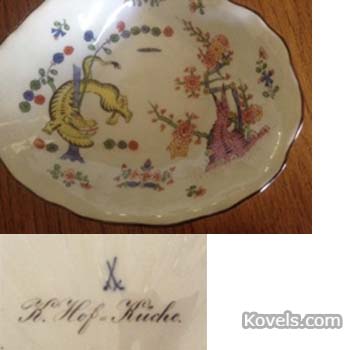Meissen Mystery
Q: We inherited this Meissen serving dish and can find nothing about the words on the bottom or the creatures on the front. Mother got it in Vienna or Germany in the late 1940s, although she said it was not new at the time. We found that “K.Hof=Kuche” translates as “K. Court – Kitchen.” We’re wondering if this was made for the Kaiser’s kitchen. Can you tell us the age, the reason for the words, and approximate value?
A: Early porcelain was made in Japan and China but wasn’t made in Europe until 1713, when the factory in Meissen, Saxony, discovered how to make it. Early Meissen porcelain was decorated with Japanese-inspired designs called Kakiemon. Your serving dish is decorated with a Kakiemon-style design called “yellow lion,” although the yellow animal looks like a tiger. It was the first porcelain pattern made by Meissen and was used on a dinner set made for August the Strong (1694–1733), King of Poland and Elector of Saxony. The abbreviation on the back of your dish is “K. Hof” stands for Königliche Hofwirtschaft. The dish is part of a set made for the Royal Hofwirtschaft kitchen. The pattern was made exclusively for the court in the 1730s, but has been made in modern times. Old pieces can sell for over $1,000, but dishes made in the 20th century sell for $200 to $300.
2 responses to “Meissen Mystery”
Leave a Reply
You must be logged in to post a comment.




It is as if Kovels does not read the question!!! Is the plate old or very old? How can one tell the difference? If Kovels does not know the answer where could the writer go for more information? How frustrating!
The answer is not clear. Is the plate 20th century or 18th?